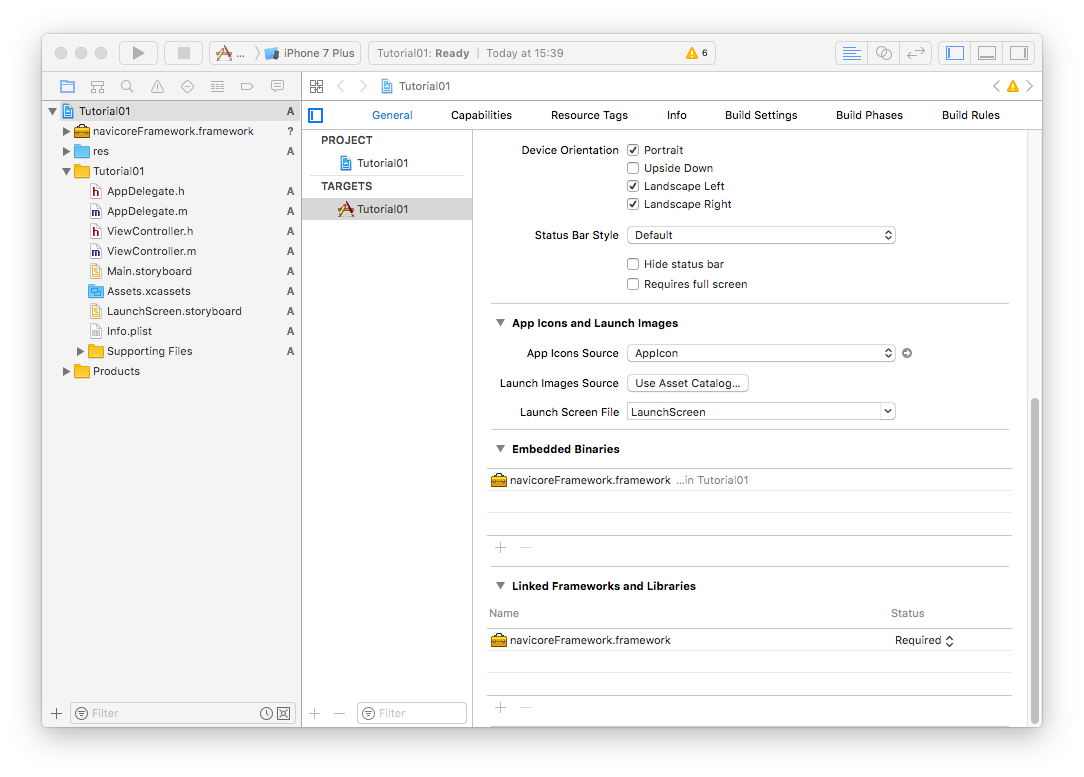01 First project
Overview
This tutorial will teach the basics to create an iOS project with the NavigationSDK. You will learn how to add the NavigationSDK framework as a project dependency, how to initialize the SDK correctly and which additional data you need to use the SDK.
At the time of writing (November 2017) Xcode 9.1 is the latest version released by Apple. The latest iOS Version is 11.1. The deployment target of the NavigationSDK framework is set to iOS 9.3. The framework is delivered as a "fat framework", including architectures for x86_64 Simulators and ARM Devices (arm64 architecture).
Note
If you just want to build and run the tutorial projects that are delivered with this SDK, you just have to copy the folders "navicoreFramework.framework" and "res" into the Tutorial folder of your choice. Open the .xcodeproj file in your local Xcode and build and run the application.
NavigationSDK files
docs(SDK documentation files)maps(prepackaged map data)res(necessary resources to run the tutorials (including the needed maps))sdk(NavigationSDK Framework "navicoreFramework.framework", including x86_64 code for running on the Simulator and ARM code for running on the device)tutorial(tutorial sources)license.key(license key for the SDK)
Attention
With your copy of the SDK you get a test license.key file. With this license.key you are able to test the SDK until a specified date. Please contact PTV if your test license.key has expired.
Create your first NavigationSDK project
To create our first NavigationSDK project you have to create a new Xcode iOS Project. Use the simplest available application type "Single View". Use "Objective-C" as the language of choice. Set "Tutorial01" as the Project name to be in sync with this tutorial.
Add Framework and Resources
Now add the navicoreFramework to the project by selecting in the left Xcode pane the top file "Tutorial01" and select the tab "General" in the main pane. Open the Mac OS Finder, go to the "sdk" folder and drag the "navicoreFramework.framework" to the area "Embedded Binaries" in Xcode.
Open the Finder again and drag the folder "res" into the project. Verify that in the tab "Build Phases", the "res" folder appears in the section "Copy Bundle Resources"
The project structure should look now like in the following picture:

Structure of the res folder
The folder "res" has the following three subdirectories:
- maps (copy your map data to here)
The maps directory is mandatory. All used maps must be copied to this folder. Deleting a map file will cause the SDK to not initialize. - addr (copy your POI data to here)
The addr directory contains the POI (Point of Interest) data and can be left empty if POIs are not used. - data (copy the rendering data and your
license.keyto here)
This directory contains the subfolders "bmp", "renderer" and "profiles" in the tutorials.
Generally, all files besides thelicense.keyin the data directory are optional. The SDK will still work without the rendering data, but the map will look incomplete.
In the top level, the *.cmp files are used for all text renderings on the map. If you delete them, no street or town names will be rendered anymore. All other files in the top level directory of data can be removed, they are only used for the tutorials.
In the bmp directory you can find all icons that are directly rendered onto the map like POI or restriction icons. If you don't need any of these icons, you can delete them. Have in mind that a blue dot will be rendered at the POI position as a fallback if POI data is present in the addr directory but icons are missing.
In the renderer directory the map design files reside. You can remove this directory if you don't want to change the map design.
The profiles directory contains files with predefined route options for various vehicles (see Tutorial 5 for loading such a file).
Note
With your SDK delivery comes a sample res folder which contains all necessary data for the complete tutorial and a map of Germany. If you want different maps, just replace the files inside the maps folder with your favored maps.
Initialize the NavigationSDK
First import the following header file of the SDK at the top of the AppDelegate.m file:
#import "navicoreFramework/NSDK_Navigation.h"
This "Umbrella"-header imports all needed header files of the SDK.
To initialize the NavigationSDK we edit the didFinishLaunchingWithOptions: function in AppDelegate.m file. The SDK initialize function needs three paths and a map name. The three paths are the maps, addr and data directories you just put in the application bundle by adding the res folder. The map name is the file name without the file extension(e.g. deu).
- (BOOL)application:(UIApplication *)application didFinishLaunchingWithOptions:(NSDictionary *)launchOptions { NSString *dir = [[NSBundle mainBundle] resourcePath]; NSString* srcPath = [dir stringByAppendingPathComponent:@"res"]; if (![[NSFileManager defaultManager] fileExistsAtPath:srcPath]){ NSLog(@"res folder doesn't exist"); return YES; } NSError * error; BOOL ret = [NSDK_Navigation initializeWithMapPath:[srcPath stringByAppendingString:@"/maps/"] mapName:@"deu" addrPath:[srcPath stringByAppendingString:@"/addr/"] appPath:[srcPath stringByAppendingString:@"/data/"] error: &error]; NSLog(@"initializeWithMapPath returns:%d error:%@", ret, error); return YES; }
That's it. You can now use the NavigationSDK. Run the app on your device or simulator and you should see the following log output in Xcode:
initializeWithMapPath returns:1 error:(null)
Attention
If initialization returns NSError equal to code: -53 you either forgot to copy the license.key file to your data directory or your test license.key has expired.